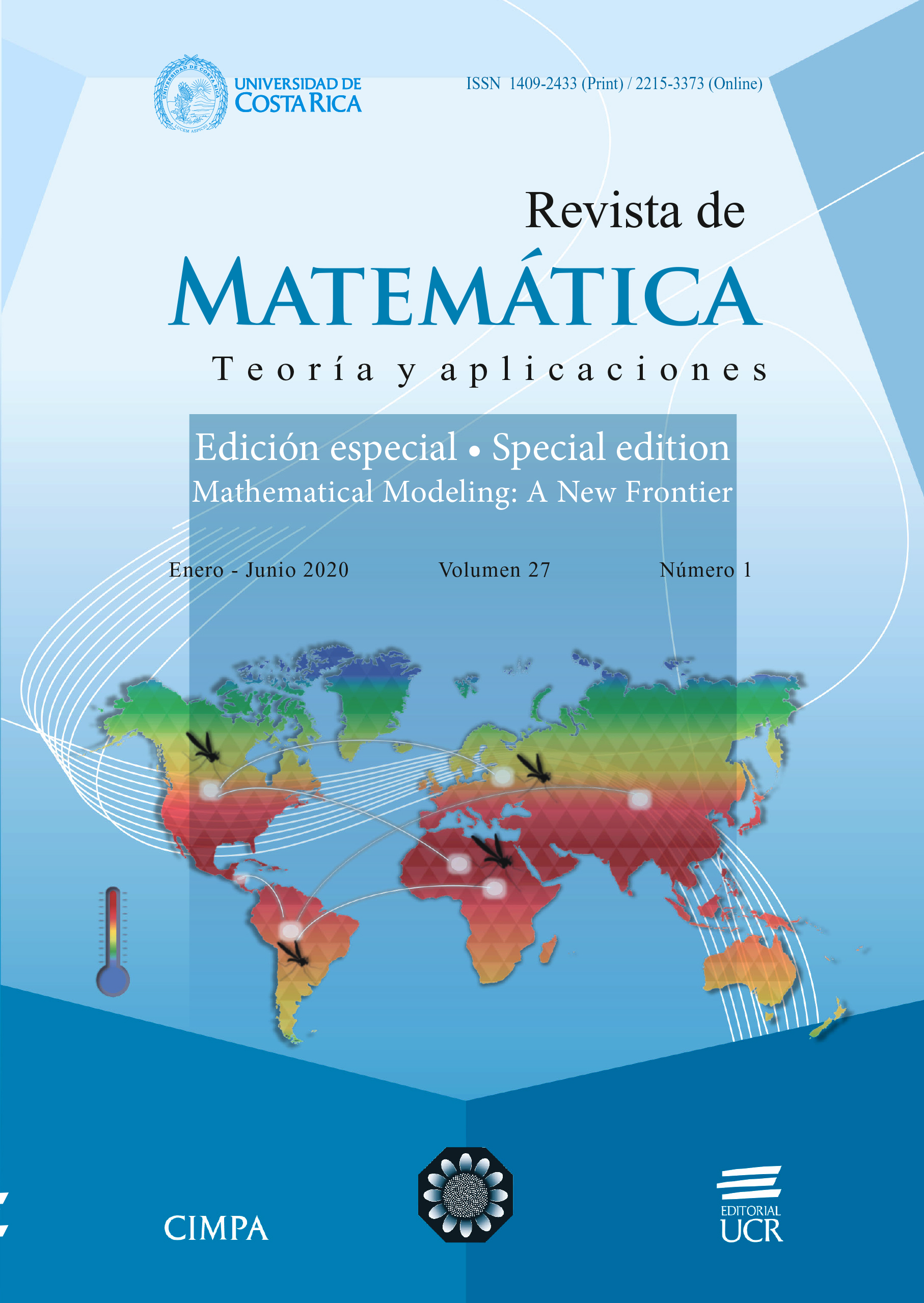Resumen
Se propone un modelo epidémico de ecuaciones diferenciales con retraso del tipo SIQR (por sus siglas en inglés) (Susceptible-Infeccioso-En cuarentena-Recuperado), con períodos arbitrariamente distribuidos en la clase de aislamiento o cuarentena. Se analizan sus características matemáticas esenciales. Además, se identifican las condiciones que respaldan la existencia de soluciones periódicas a través de la bifurcación de Hopf. Los tiempos de espera no exponenciales en la clase de cuarentena/aislamiento conducen no solo a oscilaciones sino que también pueden soportar cambios de estabilidad.
Citas
E. Beretta, Y. Kuang, Geometric stability switch criteria in delay differential systems with delay dependent parameters, SIAM J. Math. Anal. 33 (2002), no. 5, 1144–1165.
F.G. Boese, Stability with respect to the delay: On a paper of K.L. Cooke and P. van den Driessche, J. Math. Anal. and Applications 228 (1998), no.2, 293–321.
F. Brauer, C. Castillo-Chávez, Mathematical models in population biology and epidemiology, Texts in Applied Mathematics 40, Springer-Verlag, New York, 2001.
C. Castillo-Chavez, H.W. Hethcote, V. Andreasen, S.A. Levin, W.M. Liu, Cross-immunity in the dynamics of homogeneous and heterogeneous populations, in: T.G. Hallam, L.G. Gross & S. A. Levin (Eds.) Mathematical Ecology, Proceedings of the Autumn Course Research Seminars, (Trieste, 1986), World Sci. Publishing, Teaneck, NJ (1988), 303–316.
C. Castillo-Chavez, H.W. Hethcote, V. Andreasen, S.A. Levin, W.M. Liu, Epidemiological models with age structure, proportionate mixing, and cross–immunity, J. Math. Biol. 27 (1989), no. 3, 233–258.
G. Chowell, P.W. Fenimore, M.A. Castillo-Garsow, C. Castillo-Chavez, SARS outbreaks in Ontario, Hong Kong and Singapore: the role of diagnosis and isolation as a control mechanism, J. Theor. Biol. 224 (2003), no. 1, 1–8.
R. Curtiss III, The impact of vaccines and vaccinations: challenges and opportunities for modelers, Math. Biosc. Eng. 8 (2011), no. 1, 77–93.
O. Diekmann, S.A. van Gils, S.M. Verduyn Lunel, H.-O. Walther, Delay equations: Functional-, Complex- and Nonlinear Analysis, Applied Mathematical Sciences 110, Springer–Verlag, New York, 1995.
M. Erdem, M. Safan, C. Castillo-Chavez, Mathematical models of influenza with imperfect quarantine, Bull. Math. Biol. 79 (2017), no. 7, 1612–1636.
Z. Feng, W. Huang, C. Castillo-Chavez, On the role of variable latent periods in mathematical models for tuberculosis, J. Dynamics and Differential Equations 13 (2001), no. 2, 425–452.
Z. Feng, H.R. Thieme, Recurrent outbreaks of childhood diseases revisited: the impact of isolation, Math. Biosci. 128 (1995), no. 1–2, 93–130.
Z. Feng, H.R. Thieme, Endemic models with arbitrarily distributed periods of infection II: fast disease dynamics and permanent recovery, SIAM Journal on Applied Mathematics 61 (2000), no. 3, 983–1012.
Z. Feng, H.R. Thieme, Endemic models with arbitrarily distributed periods of infection I: fundamental properties of the Model, SIAM Journal on Applied Mathematics 61 (2000), no. 3, 803–833.
Z. Feng, Y. Yang, D. Xu, P. Zhang, M.M. McCauley, J.W. Glasser, Timely identification of optimal control strategies for emerging infectious diseases, J. Theor. Biol. 259 (2009), no. 1, 165–171.
L. Gao, H. Hethcote, Simulations of rubella vaccination strategies in China, Math Biosc 202 (2006), no. 2, 371–385.
G.F. Gensini, M.H. Yacoub, A.A. Conti, The concept of quarantine in history: from plague to SARS, Journal of Infection 49 (2004), no. 4, 257–261.
J.K. Hale, S.M. Verduyn-Lunel, Introduction to Functional Differential Equations, Applied Mathematical Sciences 99, Springer-Verlag, New York, 1993.
M. A. Herrera-Valdez, M. Cruz-Aponte, C. Castillo-Chavez, Multiple outbreaks for the same pandemic: local transportation and social distancing explain the different “waves” of A-H1N1pdm cases observed in Mexico during 2009, Math. Biosc. Eng. 8 (2011), no. 1, 21–48.
H.W. Hethcote, The mathematics of infectious diseases, SIAM Rev. 42 (2000), no. 4, 599–653.
H.W. Hethcote, M. Zhien, L. Shengbing, Effects of quarantine in six endemic models for infectious diseases, Math. Biosci. 180 (2002), no. 1–2, 141–160.
N.W. McLachlan, Modern operational calculus with applications in technical mathematics, Revised edition, Dover Publications, Inc., New York, 1962.
A. Mubayi, C. Kribs-Zaleta, M. Martcheva, C. Castillo-Chavez, A costbased comparison of quarantine strategies for new emerging diseases, Math. Biosc. Eng. 7 (2010), no. 3, 687–717.
M. Nuño, A mathematical model for the dynamics of influenza at the population and host level, Ph.D. Thesis, Cornell University, 2005.
M. Safan, Mathematical analysis of an SIR respiratory infection model with sex and gender disparity: special reference to influenza A, Mathematical Biosciences and Engineering 16 (2019), no. 4, 2613–2649.
M. Safan, M. Kretzschmar, K.P. Hadeler, Vaccination based control of infections in SIRS models with reinfection: special reference to pertussis, Journal of Mathematical Biology 67 (2013), no. 5, 1083–1110.
E. Shim, Prioritization of delayed vaccination for pandemic influenza, Math. Biosc. Eng. 8 (2011), no. 1, 95–112.
H.R. Thieme, Mathematics in population biology, Princeton Series in Theoretical and Computational Biology, Princeton University Press, Princeton, New Jersey, 2003.
H.R. Thieme, The transition through stages with arbitrary length distributions, and applications in epidemics, in: C. Castillo-Chavez, S. Blower, P. van den Driessche, D. Kirschner, A.A. Yakubu (Eds.) Mathematical Approaches for Emerging and Reemerging Infectious Diseases: Models, Methods, and Theory. (Minneapolis, MN, 1999), The IMA Volumes in Mathematics and its Applications, 126, Springer, New York, 2002, pp. 45–84.
Y. Yang, Z. Feng, D. Xu, Analysis of a model with multiple infectious stages and arbitrarily distributed stage durations, Math. Model. Nat. Phenom. 3 (2008), no. 7, 180–193.





